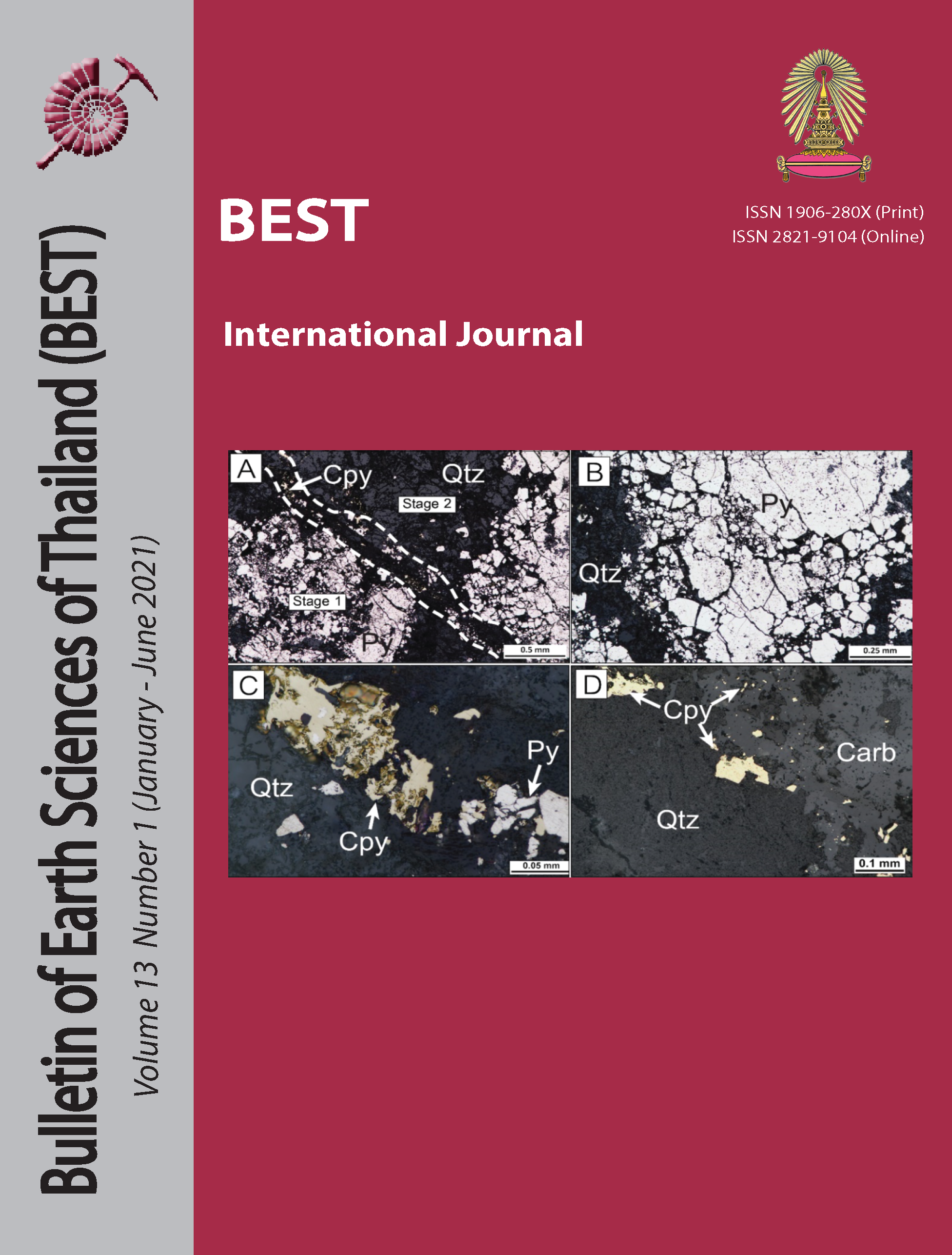Oldest Fusulinid of Khao Khad Formation, Saraburi Province
Main Article Content
Abstract
The study area is located at Khao Makok, in Khao Khad Formation, Saraburi province. It consists of limestone with a lot of fossils such as fusulinid, crinoid, coral, bivalves, etc. These collected limestone samples were prepared as thin sections for petrographic study. The fusulinid is an index fossil used to indicate the age in Carboniferous - Permian. Most of fusulinids in previous studies determined middle Middle Permian - late Middle Permian. However, Robustoscwagerina in this study determined Early Permian (Sakmarian-akhtashian). It is the oldest fusulinid of Khao Khad Formation representing that Khao Khad Formation was developed in Early Permian. In petrographic study, the rock is bioclastic rudstone. The most bioclastic grains are fusulinids that show high diversity. It indicates that the study area was deposited in outer shelf environment.
Article Details
Copyright © 2008 Department of Geology, Faculty of Science, Chulalongkorn University. Parts of an article can be photocopied or reproduced without prior written permission from the author(s), but due acknowledgments should be stated or cited accordingly.
References
Alfred R. Loeblich, J., and Tappan, H. 1988. Foraminiferal Genera and Their Classification. New York: Springer Science+Business Media.
Dawson, O., and Racey, A. 1993. Fusulinecalcareous algal biofacies of the Permian Ratburi Limestone, Saraburi, Central Thailand. Journal of Southeast Asian Earth Sciences 8: 49-65.
Dew, R. E. C., King, R., Collins, A. S., Morley, C. K., Arboit, F., and Glorie, S. 2018. Stratigraphy of deformed Permian carbonate reefs in Saraburi Province, Thailand. Journal of the Geological Society 175(1): 163-175.
Flugel, E. 2010. Microfacies of Carbonate Rocks. Second ed. Verlag Berlin Heidelberg Springer.
Hinthong, C. 1981. Geology and mineral resources of the Changwat Phranakorn Sri Ayutthaya (Map ND 47-8). Bangkok, Thailand Geological Survey Report No.4, Department of Mineral Resources (in Thai).
Hinthong, C., Chuaviroj, S., Kaewyana, W., Srisukh, S., Pholprasit, C., and Pholachan, S. 1985. Geological map of Thailand 1: 250 000 (Changwat Phranakorn Sri Ayutthaya, ND 47–8). Bangkok, Thailand: Geological Survey Division of the Department of Mineral Resources.
Morley, C. K., Ampaiwan, P., Thanudamrong, S., Kuenphan, N., and Warren, J. 2013. Development of the Khao Khwang Fold and Thrust Belt: Implications for the geodynamic setting of Thailand and Cambodia during the Indosinian Orogeny. Journal of Asian Earth Sciences 62: 705-719.
Toriyama, R., and Kanmera, K. 1979. Fusuline fossils from Thailand, Part XII. Permian fusulines from the Ratburi Limestone in the Khao Khao area, Sara Buri, central Thailand. Geology and Palaeontology of Southeast Asia, pp. 23-93.
Toriyama, R., Kanmera, K., Kaewbaidhoon, S., and Hongnusonthi, A. 1974. Biostratigraphic zonation of the Ratburi Limestone in the Khao Phlong Phrab area, Saraburi, Central Thailand. Geology and Paleontology of Southeast Asia, pp. 25-48.
Ueno, K., and Charoentitirat, T. 2011. Chapter 5. Carboniferous and Permian. In M. F. Ridd, Barber, A.T. & Crow, M.J. (ed.), The Geology of Thailand, pp. 71-136. London: Geological Society.


